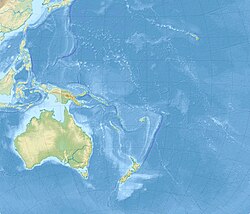Taputapuatea marae
| UNESCO World Heritage Site | |
|---|---|
 Tiki on the marae at Taputapuatea | |
| Location | Taputapuatea, Raiatea, French Polynesia, France |
| Part of | Taputapuātea |
| Criteria | Cultural: (iii)(iv)(vi) |
| Reference | 1529 |
| Inscription | 2017 (41st Session) |
| Coordinates | 16°50′15.0″S 151°21′32.4″W / 16.837500°S 151.359000°WCoordinates: 16°50′15.0″S 151°21′32.4″W / 16.837500°S 151.359000°W |
 Location of Taputapuatea marae in French Polynesia | |
Marae Taputapuatea is a large marae complex at Opoa in Taputapuatea, on the south eastern coast of Raiatea. The site features a number of marae and other stone structures and was once considered the central temple and religious center of Eastern Polynesia. In 2017 the Taputapuatea area was inscribed on the UNESCO World Heritage Sites list with Taputapuatea marae being described as the heart of the site.[1]
History[]
The sacred area of Cape Matahira-i-te-ra'i is called Te Po, where the gods reside. The original marae was dedicated to Ta'aroa. eventually the worship of 'Oro prevailed, the god of life and death. According to legend, 'Oro's descendant Hiro built the marae, giving it the name Taputapuatea, 'Sacrifices from afar'. The drum Ta'imoana was used during human sacrifices. The white rock Te Papatea-o-Ru'ea on the nearby beach was used to invest the chiefs of Ra'iatea with the red feather girdle maro 'ura. The three foot high image of the god was called 'Oro-maro-'ura, 'Oro of the red feather girdle. Taputapuatea became the center of a voyaging network as the cult of 'Oro spread.[2]
The Marae was already established by AD 1000 with significant expansion after this time.[citation needed] The marae was a place of learning where priests and navigators from all over the Pacific would gather to offer sacrifices to the gods and share their knowledge of the genealogical origins of the universe, and of deep-ocean navigation.
An alliance known as Ti'ahuauatea was established with the surrounding islands demarcating those to the west of Ra'iatea, Te Aotea, and those to the east, Te Aouri. This alliance included the Cook Islands, the Australs, Kapukapuakea in Hawaii, and Taputapuatea in New Zealand. New marae were established on each of these islands with a rock being taken from Taputapuatea, Raiatea, to act as a spiritual link. 'Oro priests from the islands gathered here periodically, participating in human sacrifices to 'Oro.[2]
However the alliance was finally broken when fighting broke out at a gathering and the two leading high priests representing the alliance were killed. The people of Ao-tea fled the island, leaving via the reef passage of Te Ava-rua rather than the sacred passage of Te Ava-mo'a, which was considered a bad omen. An attempt was made in 1995 to heal this wrongdoing.[2]: 35
Around 1763, warriors from Bora Bora attacked the island, defeating Tupaia, and ransacked the island. This included destroying the god-houses at Taputapuatea, wrecking the platform, and cutting down the sheltering trees.[2]: 36
James Cook, Joseph Banks, Daniel Solander and Tupaia arrived aboard the Endeavour on 20 July 1769, to take possession of Raiatea, Taha'a, Huahine and Bora Bora in the name of King George III of the United Kingdom. This seemed to be the culmination of a prophecy made by the wizard priest Vaita that a new people would arrive aboard a canoe without an outrigger and take possession of the islands.[2]: 209–210
Research and restoration[]

When Te Rangi Hīroa visited Taputapuatea in 1929 he was overcome by the desolate state in which he found this great marae and wrote:
I had made my pilgrimage to Taputapu-atea, but the dead could not speak to me. It was sad to the verge of tears. I felt a profound regret, a regret for — I knew not what. Was it for the beating of the temple drums or the shouting of the populace as the king was raised on high? Was it for the human sacrifices of olden times? It was for none of these individually but for something at the back of them all, some living spirit and divine courage that existed in ancient times of which Taputapu-atea was a mute symbol. It was something that we Polynesians have lost and cannot find, something that we yearn for and cannot recreate. The background in which that spirit was engendered has changed beyond recovery. The bleak wind of oblivion had swept over Opoa. Foreign weeds grew over the untended courtyard, and stones had fallen from the sacred altar of Taputapu-atea. The gods had long ago departed.[3]
The archaeological remains of Marae Taputapuatea were restored in 1994 and work to preserve the site continues.
Association Na Papa E Va'u Raiatea is a cultural association formed by the people of Opoa acting for the preservation of the Marae Taputapuatea.[2]: 31 Thanks to its work, Marae Taputapuatea is listed on the World Heritage List since July 9, 2017. The association is creating and reviving connections between communities of the Polynesian triangle and throughout the Pacific region.
References[]
- ^ "Taputapuātea". UNESCO. Retrieved 18 July 2017.
- ^ Jump up to: a b c d e f Salmond, Anne (2010). Aphrodite's Island. Berkeley: University of California Press. pp. 26-27. ISBN 9780520261143.
- ^ Buck, Peter H. (1938). Vikings of the Sunrise. Philadelphia: Lippincott. pp. 81–82.
Further reading[]
- Finney, Ben (2000). "The Sin at Awarua". In Hanlon, David L.; Geoffrey Miles White (eds.). Voyaging through the Contemporary Pacific. Pacific Formations. Rowman & Littlefield. pp. 298–332. ISBN 0-7425-0045-4.
- Howe, K. R., ed. (2007). "Navigation". Vaka Moana: Voyages of the Ancestors. Honolulu: University of Hawaii Press. ISBN 978-0-8248-3213-1.
External links[]
- Tahiti and Society Islands mythology
- Polynesian culture
- Educational institutions established in the 10th century
- Archaeological sites in French Polynesia
- World Heritage Sites in France
- World Heritage Sites in French Polynesia
- Religious buildings and structures in French Polynesia

